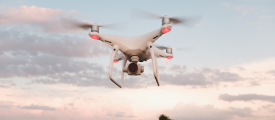By Rupin Chopra and Shantam Sharma
Introduction
The drone market in India, valued at USD 1.1 billion, is projected to reach USD 2.4 billion by 2032, with a compound annual growth rate of 9.13%. As this market experiences exponential growth, implementing a robust regulatory framework has become imperative. Recognizing the opportunities drones present across various sectors, the Ministry of Civil Aviation, Government of India, introduced the Drone Rules, 2021[1] (hereinafter referred to as “Rules”). These Rules aim to foster innovation while ensuring safety and security. They provide guidelines for drone operation, classification, registration requirements, and procedures to promote safe and responsible drone usage. This article delves into the Rules, offering a comprehensive overview of drone regulation in India.
The Essentials of Drone Policy
Definition of Drone
As per Rule 3(i), a drone is defined as an aircraft that can operate autonomously or be remotely operated without a pilot on board. Rule 5 classifies drones into various categories:
Procedure for Registration of Drone
According to Rule 14, anyone wishing to operate a drone must register on the Digital Sky platform[2] and obtain a Unique Identification Number (UIN). The procedure for registration as per Rule 15 is as follows:
- The applicant must complete Form D-2 on the Digital Sky platform, pay a fee of Rs. 100, and provide the necessary details.
- The UIN will be linked to the drone’s unique serial number, including its flight control module and remote pilot station.
Furthermore, as per Rule 18, if a drone registered under these Rules is permanently lost or damaged, the user can apply for deregistration by completing Form D-3 on the Digital Sky platform and paying a fee of Rs. 100.
Remote Pilot License
Under Rule 31, obtaining a remote pilot license is mandatory for operating a drone. However, the Drone (Amendment) Rules, 2022[3] abolished the need for a drone pilot license. Now, the remote pilot certificate is issued by a Director General of Civil Aviation (DGCA)-authorized Remote Pilot Organization. The eligibility criteria for obtaining a remote pilot certificate are:
- Age between 18 and 65 years.
- Passed the 10th grade or its equivalent from a recognized board.
- Completed remote pilot training from a recognized organization.
The certificate is valid for 10 years, provided it is listed on the Digital Sky platform.
Safety Features
Drone owners must ensure their drones are equipped with the following safety measures[4]:
- ‘No Permission – No Takeoff’ hardware and firmware.
- Real-time tracking beacon that communicates the drone’s location, altitude, speed, and UIN.
- Geo-fencing capability.
Airspace Map
Understanding the airspace map is crucial for safe and legal drone operations. The airspace map outlines designated zones[5] where drones can and cannot be operated. As per Rule 3(l), the airspace is categorized as follows:
- Green Zone: Airspace up to 400 ft that is not designated as a red or yellow zone, and up to 200 ft above areas located 8-12 km from an operational airport’s perimeter. Drones weighing up to 500 kg do not require permission for operation in the green zone.
- Yellow Zone: Airspace above 400 ft in a designated green zone, above 200 ft in areas 8-12 km from an operational airport’s perimeter, and above ground in areas 5-8 km from an operational airport’s perimeter. Operating in the yellow zone requires permission from the relevant air traffic control authority (e.g., Airport Authority of India, Indian Air Force, Navy, Hindustan Aeronautics Limited).
- Red Zone: A ‘no-drone zone’ where drone operations are only permitted with authorization from the Government of India.
Conclusion
India’s drone policy is pivotal in harnessing the transformative potential of drones. By fostering innovation and ensuring safety and security, these Rules represent a forward-thinking approach to regulating drone operations. They provide a comprehensive framework that balances regulatory requirements with growth opportunities. As the drone industry evolves, India’s commitment to innovation and safe drone operation will significantly shape the future of drone technology within the country.
Ritvik Kashyap, Intern at S.S. Rana & Co. has assisted in the research of this article.
[1] Available at: https://www.dgca.gov.in/digigov-portal/jsp/dgca/homePage/viewPDF.jsp?page=InventoryList/headerblock/drones/Drone%20Rules%202021.pdf
[2] Available at: https://digitalsky.dgca.gov.in/home
[3] Available at: https://www.civilaviation.gov.in/sites/default/files/2023-10/Drone%20%28Amendment%29%20Rules%2C%202022%20dated%2011%20Feb%202022_0.pdf
[4] Rule 12 of the Drone Rules, 2021, Available at: https://www.dgca.gov.in/digigov-portal/jsp/dgca/homePage/viewPDF.jsp?page=InventoryList/headerblock/drones/Drone%20Rules%202021.pdf
[5] Available at: https://pib.gov.in/PressReleasePage.aspx?PRID=1757850
Related Posts
Drone Flight Delivery of Covid-19 Vaccines
India: Flying drones to be legal in the Country beginning December!!


